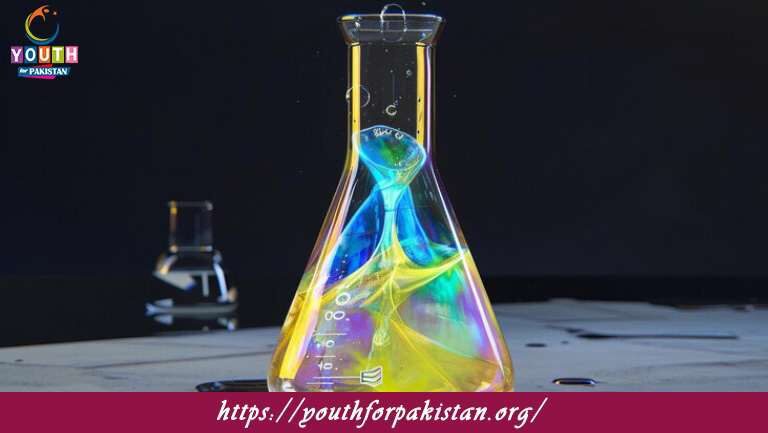10th Class Chemistry Chapter 9 MCQs with Answers

Strengthen your understanding of chemical equilibrium with these targeted MCQs. Topics include dynamic equilibrium, Le Chatelier’s principle, and factors affecting equilibrium. Boost your preparation using trending keywords like “chemical equilibrium quiz questions” and “10th class chemistry MCQs for exams.” This guide ensures conceptual clarity and exam success.
In a chemical equilibrium, the rate of the forward reaction:
a) Increases
b) Decreases
c) Becomes zero
d) Remains constant
Which of the following factors can affect the position of equilibrium?
a) Temperature
b) Pressure
c) Concentration of reactants and products
d) All of the above
The equilibrium constant (K
c) expression is defined as:
a) [Products] / [Reactants]
b) [Reactants] / [Products]
c) [Products] × [Reactants]
d) [Reactants] + [Products]
If the value of the equilibrium constant (K
c) is very large, it indicates that the equilibrium favors:
a) The reactants
b) The products
c) Both reactants and products in equal amounts
d) No reaction has occurred
The forward and reverse reactions occur at the same rate in a state of:
a) Dynamic equilibrium
b) Static equilibrium
c) Chemical imbalance
d) Non-equilibrium
What does a double-headed arrow between reactants and products in a chemical equation represent?
a) Reactants are greater than products
b) Products are greater than reactants
c) The reaction can proceed in both directions
d) The reaction cannot proceed
The equilibrium constant (K
c) for the reaction: N2 + 3H2 ⇌ 2NH3 is:
a) [NH3] / [N2] × [H2]^3
b) [NH3] / [N2] + [H2]^3
c) [N2] × [H2]^3 / [NH3]
d) [N2] + [H2]^3 / [NH3]
If the concentration of reactants is increased, the equilibrium will shift in the direction of:
a) Reactants
b) Products
c) No change in equilibrium position
d) Both reactants and products in equal amounts
The equilibrium constant (K
c) for the reaction: CO + H2O ⇌ CO2 + H2 is:
a) [CO2] × [H2] / [CO] × [H2O]
b) [CO2] × [H2O] / [CO] × [H2]
c) [CO] × [H2] / [CO2] × [H2O]
d) [CO] × [H2O] / [CO2] × [H2]
Which of the following statements is true for a system at equilibrium?
a) The concentrations of reactants and products are equal.
b) The concentrations of reactants and products are constant.
c) The concentrations of reactants and products are zero.
d) The concentrations of reactants are greater than products.
The equilibrium constant (K
c) for the reaction: N2O4 ⇌ 2NO2 is:
a) [NO2] / [N2O4]^2
b) [N2O4] / [NO2]^2
c) [NO2]^2 / [N2O4]
d) [N2O4]^2 / [NO2]
Le Chatelier’s principle states that when a system at equilibrium is subjected to a change
in temperature, pressure, or concentration of reactants or products, the system will:
a) Remain unchanged
b) Shift to the left
c) Shift to the right
d) Completely react to form products
The equilibrium constant (K
c) for the reaction: 2SO2 + O2 ⇌ 2SO3 is:
a) [SO3]^2 / [SO2] × [O2]
b) [SO2] × [O2] / [SO3]^2
c) [SO3] × [SO2] / [O2]^2
d) [SO2] × [O2]^2 / [SO3]
The concentration of reactants and products in a dynamic equilibrium:
a) Keeps changing continuously
b) Becomes zero
c) Remains constant
d) Decreases rapidly
Which of the following changes would shift the equilibrium position to the right?
a) Decreasing temperature for an exothermic reaction
b) Increasing pressure for a gaseous reaction with fewer moles of gas
c) Increasing the concentration of reactants
d) Decreasing the concentration of products
The equilibrium constant (K
c) for the reaction: N2 + 3H2 ⇌ 2NH3 is:
a) [NH3] / [N2] × [H2]^3
b) [NH3] / [N2] + [H2]^3
c) [N2] × [H2]^3 / [NH3]
d) [N2] + [H2]^3 / [NH3]
The equilibrium constant (K
c) for the reaction: CO + H2O ⇌ CO2 + H2 is:
a) [CO2] × [H2] / [CO] × [H2O]
b) [CO2] × [H2O] / [CO] × [H2]
c) [CO] × [H2] / [CO2] × [H2O]
d) [CO] × [H2O] / [CO2] × [H2]
The equilibrium constant (K
c) for the reaction: N2O4 ⇌ 2NO2 is:
a) [NO2] / [N2O4]^2
b) [N2O4] / [NO2]^2
c) [NO2]^2 / [N2O4]
d) [N2O4]^2 / [NO2]
Le Chatelier’s principle predicts that an increase in temperature will shift the equilibrium
position to the direction of the reaction that:
a) Absorbs heat
b) Releases heat
c) Produces more moles of gas
d) Reduces the concentration of reactants
The equilibrium constant (K
c) for the reaction: 2SO2 + O2 ⇌ 2SO3 is:
a) [SO3]^2 / [SO2] × [O2]
b) [SO2] × [O2] / [SO3]^2
c) [SO3] × [SO2] / [O2]^2
d) [SO2] × [O2]^2 / [SO3]
If the concentration of products is increased, the equilibrium will shift in the direction of:
a) Reactants
b) Products
c) No change in equilibrium position
d) Both reactants and products in equal amounts
The equilibrium constant (K
c) for the reaction: N2 + 3H2 ⇌ 2NH3 is:
a) [NH3] / [N2] × [H2]^3
b) [NH3] / [N2] + [H2]^3
c) [N2] × [H2]^3 / [NH3]
d) [N2] + [H2]^3 / [NH3]
Which of the following statements is true for a system at equilibrium?
a) The concentrations of reactants and products are equal.
b) The concentrations of reactants and products are constant.
c) The concentrations of reactants and products are zero.
d) The concentrations of reactants are greater than products.
The equilibrium constant (K
c) for the reaction: CO + H2O ⇌ CO2 + H2 is:
a) [CO2] × [H2] / [CO] × [H2O]
b) [CO2] × [H2O] / [CO] × [H2]
c) [CO] × [H2] / [CO2] × [H2O]
d) [CO] × [H2O] / [CO2] × [H2]
The equilibrium constant (K
c) for the reaction: N2O4 ⇌ 2NO2 is:
a) [NO2] / [N2O4]^2
b) [N2O4] / [NO2]^2
c) [NO2]^2 / [N2O4]
d) [N2O4]^2 / [NO2]
Le Chatelier’s principle states that when a system at equilibrium is subjected to a change
in temperature, pressure, or concentration of reactants or products, the system will:
a) Remain unchanged
b) Shift to the left
c) Shift to the right
d) Completely react to form products
The equilibrium constant (K
c) for the reaction: 2SO2 + O2 ⇌ 2SO3 is:
a) [SO3]^2 / [SO2] × [O2]
b) [SO2] × [O2] / [SO3]^2
c) [SO3] × [SO2] / [O2]^2
d) [SO2] × [O2]^2 / [SO3]
The equilibrium constant (K
c) for the reaction: N2 + 3H2 ⇌ 2NH3 is:
a) [NH3] / [N2] × [H2]^3
b) [NH3] / [N2] + [H2]^3
c) [N2] × [H2]^3 / [NH3]
d) [N2] + [H2]^3 / [NH3]
The equilibrium constant (K
c) for the reaction: CO + H2O ⇌ CO2 + H2 is:
a) [CO2] × [H2] / [CO] × [H2O]
b) [CO2] × [H2O] / [CO] × [H2]
c) [CO] × [H2] / [CO2] × [H2O]
d) [CO] × [H2O] / [CO2] × [H2]
The equilibrium constant (K
c) for the reaction: N2O4 ⇌ 2NO2 is:
a) [NO2] / [N2O4]^2
b) [N2O4] / [NO2]^2
c) [NO2]^2 / [N2O4]
d) [N2O4]^2 / [NO2]
Which of the following changes would shift the equilibrium position to the right?
a) Decreasing temperature for an exothermic reaction
b) Increasing pressure for a gaseous reaction with fewer moles of gas
c) Increasing the concentration of reactants
d) Decreasing the concentration of products
The equilibrium constant (K
c) for the reaction: N2 + 3H2 ⇌ 2NH3 is:
a) [NH3] / [N2] × [H2]^3
b) [NH3] / [N2] + [H2]^3
c) [N2] × [H2]^3 / [NH3]
d) [N2] + [H2]^3 / [NH3]
The equilibrium constant (K
c) for the reaction: CO + H2O ⇌ CO2 + H2 is:
a) [CO2] × [H2] / [CO] × [H2O]
b) [CO2] × [H2O] / [CO] × [H2]
c) [CO] × [H2] / [CO2] × [H2O]
d) [CO] × [H2O] / [CO2] × [H2]
The equilibrium constant (K
c) for the reaction: N2O4 ⇌ 2NO2 is:
a) [NO2] / [N2O4]^2
b) [N2O4] / [NO2]^2
c) [NO2]^2 / [N2O4]
d) [N2O4]^2 / [NO2]
If the concentration of products is increased, the equilibrium will shift in the direction of:
a) Reactants
b) Products
c) No change in equilibrium position
d) Both reactants and products in equal amounts
The equilibrium constant (K
c) for the reaction: N2 + 3H2 ⇌ 2NH3 is:
a) [NH3] / [N2] × [H2]^3
b) [NH3] / [N2] + [H2]^3
c) [N2] × [H2]^3 / [NH3]
d) [N2] + [H2]^3 / [NH3]
The equilibrium constant (K
c) for the reaction: CO + H2O ⇌ CO2 + H2 is:
a) [CO2] × [H2] / [CO] × [H2O]
b) [CO2] × [H2O] / [CO] × [H2]
c) [CO] × [H2] / [CO2] × [H2O]
d) [CO] × [H2O] / [CO2] × [H2]
The equilibrium constant (K
c) for the reaction: N2O4 ⇌ 2NO2 is:
a) [NO2] / [N2O4]^2
b) [N2O4] / [NO2]^2
c) [NO2]^2 / [N2O4]
d) [N2O4]^2 / [NO2]
Le Chatelier’s principle states that when a system at equilibrium is subjected to a change
in temperature, pressure, or concentration of reactants or products, the system will:
a) Remain unchanged
b) Shift to the left
c) Shift to the right
d) Completely react to form products
The equilibrium constant (K
c) for the reaction: 2SO2 + O2 ⇌ 2SO3 is:
a) [SO3]^2 / [SO2] × [O2]
b) [SO2] × [O2] / [SO3]^2
c) [SO3] × [SO2] / [O2]^2
d) [SO2] × [O2]^2 / [SO3]
The equilibrium constant (K
c) for the reaction: N2 + 3H2 ⇌ 2NH3 is:
a) [NH3] / [N2] × [H2]^3
b) [NH3] / [N2] + [H2]^3
c) [N2] × [H2]^3 / [NH3]
d) [N2] + [H2]^3 / [NH3]
Which of the following statements is true for a system at equilibrium?
a) The concentrations of reactants and products are equal.
b) The concentrations of reactants and products are constant.
c) The concentrations of reactants and products are zero.
d) The concentrations of reactants are greater than products.
The equilibrium constant (K
c) for the reaction: CO + H2O ⇌ CO2 + H2 is:
a) [CO2] × [H2] / [CO] × [H2O]
b) [CO2] × [H2O] / [CO] × [H2]
c) [CO] × [H2] / [CO2] × [H2O]
d) [CO] × [H2O] / [CO2] × [H2]
The equilibrium constant (K
c) for the reaction: N2O4 ⇌ 2NO2 is:
a) [NO2] / [N2O4]^2
b) [N2O4] / [NO2]^2
c) [NO2]^2 / [N2O4]
d) [N2O4]^2 / [NO2]
If the concentration of products is increased, the equilibrium will shift in the direction of:
a) Reactants
b) Products
c) No change in equilibrium position
d) Both reactants and products in equal amounts
The equilibrium constant (K
c) for the reaction: N2 + 3H2 ⇌ 2NH3 is:
a) [NH3] / [N2] × [H2]^3
b) [NH3] / [N2] + [H2]^3
c) [N2] × [H2]^3 / [NH3]
d) [N2] + [H2]^3 / [NH3]
The equilibrium constant (K
c) for the reaction: CO + H2O ⇌ CO2 + H2 is:
a) [CO2] × [H2] / [CO] × [H2O]
b) [CO2] × [H2O] / [CO] × [H2]
c) [CO] × [H2] / [CO2] × [H2O]
d) [CO] × [H2O] / [CO2] × [H2]
The equilibrium constant (K
c) for the reaction: N2O4 ⇌ 2NO2 is:
a) [NO2] / [N2O4]^2
b) [N2O4] / [NO2]^2
c) [NO2]^2 / [N2O4]
d) [N2O4]^2 / [NO2]
Le Chatelier’s principle states that when a system at equilibrium is subjected to a change
in temperature, pressure, or concentration of reactants or products, the system will:
a) Remain unchanged
b) Shift to the left
c) Shift to the right
d) Completely react to form products
The equilibrium constant (K
c) for the reaction: 2SO2 + O2 ⇌ 2SO3 is:
a) [SO3]^2 / [SO2] × [O2]
b) [SO2] × [O2] / [SO3]^2
c) [SO3] × [SO2] / [O2]^2
d) [SO2] × [O2]^2 / [SO3]
The equilibrium constant (K
c) for the reaction: N2 + 3H2 ⇌ 2NH3 is:
a) [NH3] / [N2] × [H2]^3
b) [NH3] / [N2] + [H2]^3
c) [N2] × [H2]^3 / [NH3]
d) [N2] + [H2]^3 / [NH3]
Which of the following statements is true for a system at equilibrium?
a) The concentrations of reactants and products are equal.
b) The concentrations of reactants and products are constant.
c) The concentrations of reactants and products are zero.
d) The concentrations of reactants are greater than products.
The equilibrium constant (K
c) for the reaction: CO + H2O ⇌ CO2 + H2 is:
a) [CO2] × [H2] / [CO] × [H2O]
b) [CO2] × [H2O] / [CO] × [H2]
c) [CO] × [H2] / [CO2] × [H2O]
d) [CO] × [H2O] / [CO2] × [H2]
The equilibrium constant (K
c) for the reaction: N2O4 ⇌ 2NO2 is:
a) [NO2] / [N2O4]^2
b) [N2O4] / [NO2]^2
c) [NO2]^2 / [N2O4]
d) [N2O4]^2 / [NO2]
If the concentration of products is increased, the equilibrium will shift in the direction of:
a) Reactants
b) Products
c) No change in equilibrium position
d) Both reactants and products in equal amounts
The equilibrium constant (K
c) for the reaction: N2 + 3H2 ⇌ 2NH3 is:
a) [NH3] / [N2] × [H2]^3
b) [NH3] / [N2] + [H2]^3
c) [N2] × [H2]^3 / [NH3]
d) [N2] + [H2]^3 / [NH3]
The equilibrium constant (K
c) for the reaction: CO + H2O ⇌ CO2 + H2 is:
a) [CO2] × [H2] / [CO] × [H2O]
b) [CO2] × [H2O] / [CO] × [H2]
c) [CO] × [H2] / [CO2] × [H2O]
d) [CO] × [H2O] / [CO2] × [H2]
The equilibrium constant (K
c) for the reaction: N2O4 ⇌ 2NO2 is:
a) [NO2] / [N2O4]^2
b) [N2O4] / [NO2]^2
c) [NO2]^2 / [N2O4]
d) [N2O4]^2 / [NO2]
Le Chatelier’s principle states that when a system at equilibrium is subjected to a change in temperature, pressure, or concentration of reactants or products, the system will:
a) Remain unchanged
b) Shift to the left
c) Shift to the right
d) Completely react to form products
The equilibrium constant (K
c) for the reaction: 2SO2 + O2 ⇌ 2SO3 is:
a) [SO3]^2 / [SO2] × [O2]
b) [SO2] × [O2] / [SO3]^2
c) [SO3] × [SO2] / [O2]^2
d) [SO2] × [O2]^2 / [SO3]
If you are interested to enhance your knowledge regarding Physics, Chemistry, Biology, and Computer please click on the link of each category, you will be redirected to dedicated website for each category.





